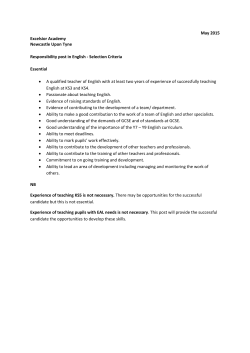
A qualitative study of entry and teaching strategies for GCSE
Centre for Education Research and Practice A qualitative study of entry and teaching strategies for GCSE Mathematics This paper reports on the findings of an exploratory study using qualitative methods to explore school level entry and teaching strategies for GCSE Mathematics. Semi-structured interviews were conducted with four heads of department for GCSE Mathematics, nine teachers of GCSE Mathematics and two examinations officers exploring five key areas: i) entry strategies for GCSE Mathematics prior to the accountability changes announced in September 2013; ii) entry strategies post-accountability changes; iii) the process for devising entry strategies within the school; iv) the drivers behind the chosen entry strategies and potential consequences; and v) the effects of entry strategies on teaching and how students are prepared for assessments. Interviews were transcribed verbatim and analysed by two researchers using thematic analysis. The main theme emerging from the data related to the way in which the pressure to achieve results, particularly around the grade C threshold, drove behaviour in schools, both in terms of the entry strategies that schools used and the teaching methods used to prepare students for assessments. This led to schools becoming pre-occupied with attempts to maximise results and a strategic focus on the C/D borderline, potentially at the expense of supporting effective teaching and learning. The entry strategies adopted by the schools were highly complex and individualistic, meaning that a number of strategies were identified; this included the use of early and multiple entry (both across and within examination series), as well a strategic approach to choosing with specification and tier to enter students to. It was clear that schools invested considerable time and effort in developing their entry strategies, then refined these in response to several factors, including the success of previous strategies, the availability of assessments and external pressures. Alongside the use of strategic entry, schools were also highly strategic in the way in which students were prepared for assessments. Thus, students were often coached to pass examinations, with teaching being focused upon certain topics that were likely to appear on the assessments or those where students were considered likely to achieve marks. To facilitate this, schools ‘set’ students into teaching groups that were targeted to achieve particular grades, frequently moving students between these after each examination series. This fluidity allowed schools to focus resources on particular students, typically those on the C/D borderline, and was considered an effective strategy for increasing the chances that a student would achieve a grade C. Whilst such practices are likely to be inevitable, even in an examination system where students are entered only once, the use of early and multiple entry is likely to have facilitated this, since schools had considerable data upon which to base their decisions. There were several perceived consequences of the behaviour described above, in terms of the effects on student motivation, teacher satisfaction and national examination outcomes. For example, such practices were considered likely to have inflated the proportion of students achieving the grade C threshold at the national level. However, this perceived increase was not necessarily considered representative of the mathematical ability of the cohort. Rather, strategic entry and teaching practices were thought to artificially inflate outcomes, prompting concerns regarding the effects of strategic behaviour on students’ learning. Rachel Taylor, Senior Research Associate, CERP cerp.org.uk Copyright © 2015 AQA Education and its licensors. All rights reserved. AQA Education (AQA) is a registered charity (registered charity number 1073334) and a company limited by guarantee registered in England and Wales (company number 3644723). Registered address: AQA, Devas Street, Manchester M15 6EX.
© Copyright 2025












